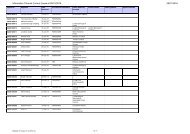RCGP-2014-poster-abstracts
RCGP-2014-poster-abstracts
RCGP-2014-poster-abstracts
Create successful ePaper yourself
Turn your PDF publications into a flip-book with our unique Google optimized e-Paper software.
• The index of suspicion amongst frontline clinicians for potentially lethal sepsis in children has been raised <br />
• Assessment, decision-‐making and management plans are evidence-‐based and protocol-‐driven <br />
• Early clinical management – basic life support, investigations and empiric antimicrobial prescribing – should now <br />
be the same for all health staff region-‐wide <br />
• Sepsis-‐related mortality has significantly reduced since the introduction of the procedure <br />
• Social and micro-‐economic healthcare burdens have reduced <br />
• There is scope to build on these successes and further validate the clinical intervention strategy by studying, for <br />
example, the effects of the broadened use of empiric antibiotics (Ceftriaxone, Gentamycin) on bacterial ecology. <br />
After spending 7 years living in Bangladesh and working across the south Asian sub-‐continent, the Kimberley seems <br />
to me to be a Fourth World almost on its own. Any research from elsewhere will have to be intelligently interpreted <br />
before it can be considered relevant, applicable and without risk of bias. It is easy to find criticism of this tool: over-treatment;<br />
inappropriate treatment of viral disease; risk of developing antimicrobial resistance. Yet so far, in trying <br />
to address the WHO’s fourth Millenium Development Goal here in remote Australia, the Kimberley Unwell Child <br />
Procedure seems to be making a difference saving children from dying from bacterial sepsis. <br />
[1] Source: World Federation Paediatric Intensive & Critical Care Societies. Sepsis Initiative (<strong>2014</strong>). Available at <br />
http://www.wfpiccs.org/projects/sepsis-‐initiative/ <br />
[2] Compliance in measuring and recording each step of the Procedure for febrile children who fitted the criterion of “no evident source of <br />
infection” was low – 25%. <br />
[3] Childhood Mortality in the Kimberley Region, 1 July 2010 to 30 June 2013: An Audit of Mortality Incidence by Age, Causality and Locality. <br />
John Boulton, Agi D’Amico; Western Australia Country Health Service. November 2013. <br />
P047 Rheumatic fever: Feasibility of a population-‐based screening programme targeting school children in a <br />
rural village in Nepal <br />
Sindhu Pathmabaskaran; Sarayu Sanguhan <br />
London Deanery GP trainees <br />
Objectives: To demonstrate the feasibility of a local screening program for ARF and GAS pharyngitis in school aged <br />
children in a rural village of Manthali, located in central Nepal.MethodPopulation based study targeting the <br />
prevention of rheumatic heart disease through early detection of ARF using the resources available. 479 school <br />
children aged between 7-‐17 years old from two local private schools were selected for the screening programme. <br />
Laboratory investigations, data collection and analysis were performed at Tamakoshi Cooperative Hospital, Manthali. <br />
The initial stage of the screening programme was comprised of clinical examination and standardised history taking. <br />
Children found to have a cardiac murmur were then asked to attend Tamakoshi Cooperative hospital for blood tests. <br />
Diagnoses of suspected cases of ARF and GAS pharyngitis were made using the Modified Jones criteria. <br />
Results: Of the 479 children screened in the programme, just over a third (164/479) were found to have a murmur. <br />
To date, 31.7% children have returned for blood tests. Of those, 11 children had clinical evidence suggestive of GAS <br />
pharyngitis and were treated with a short course of antibiotics in line with the primary prevention protocol. Two <br />
children had clinical evidence suggestive of ARF and were treated with a course of antibiotics followed by referral to <br />
Shahid Gangalal National Heart Hospital, Kathmandu. <br />
Conclusion: The implementation of this practical screening programme in a resource poor region with high rates of <br />
ARF and RHD is a feasible and affordable public health measure. <br />
P048 <br />
care <br />
Circumcision – an evaluation of post-‐operative complications in neonatal males circumcised in primary <br />
Zoya Kiani; Tahmeena Dean <br />
University of Manchester <br />
Background: Circumcision is the most frequently performed surgical procedure in human history. The most common <br />
post-‐operative complications of removing the foreskin include bleeding, swelling and dysuria. <br />
Method: Medical records of all children circumcised at the practice since the service began in November 2013, were <br />
analysed. 173 records were reviewed for evidence of post-‐operative complications. <br />
38



